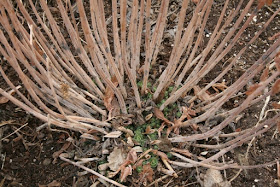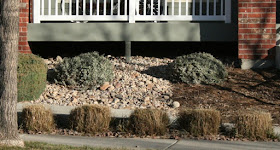Thinking of starting a vegetable garden? Growing
your own vegetables is rewarding in many ways.
Here are some ideas to help you
be successful. First, start smaIl.
You're better off to begin with a small plot because it's easier to manage
and you're more likely to stick with it. Second, grow what you'll eat. If you
don't like tomatoes, don't grow them.
Grow what you're likely to pick, prepare
and eat. Third, get into the habit of visiting your vegetable garden at least
once a day. Make it a priority.
One way to help you remember your garden needs attention every day
is to plant your garden where you can see it when you look out the window.
Don't be
discouraged if you have really poor soil. Build a raised bed. Soil is
everything when it comes to growing good, healthy vegetables and a raised bed
makes it easy to add the right soil.
Containers are also a good choice for
beginning gardeners. Container vegetable gardening allows you to grow your own
produce almost anywhere. You can start small and learn as you grow. Two
advantages of growing in containers. It's easy to get the right soil mix and
you can move containers to the ideal spot for the best growing conditions. Finally, keep a
journal. Today's smartphones make it easy to snap a picture of your garden's
progress. You can look at the pictures and recall what worked and which things
need to be changed. This will help you plan next year's garden.
Tuesday, March 29, 2016
Tuesday, March 22, 2016
What can I plant in early spring?
Last
week’s snow has melted away and it’s time to get back to gardening outside. The good
news is that there is a lot of moisture in this last snowfall, something we
really needed. So when the ground clears and dries up in the garden,
which vegetables can we plant from late March into April? We can plant many cool weather
vegetable seeds directly in the ground.
Beets, broccoli, cabbage, kale,
lettuce, peas, spinach, turnips like the cooler spring temperatures and can be
planted from seed now.
You can also plant broccoli, cabbage, kale and spinach from starts now, just be sure you harden
them off before you plant them.
Onions and garlic can also be planted now.
Onions are planted from seed, sets and plants.
Garlic is planted from
individual cloves. Potatoes should be planted later in April. Egg-sized seed
potatoes can be planted whole. Larger seed potatoes can be cut in half or
quartered and then planted.
Make sure you have at least one set of
"eyes" on each piece you plant. Always select certified seed
potatoes. Supermarket potatoes are treated to prevent them from sprouting. This
is the time to plant perennial vegetables, including rhubarb and asparagus.
Rhubarb and asparagus are available as bare-root crowns. Don't harvest rhubarb or asparagus during their
first season. This will allow the plant to establish. Rhubarb and asparagus can
produce for 10 years or more, so pick a spot in the garden where they won't be
disturbed for many seasons.
Before planting your seeds, starts or crowns, amend
your soil with compost, peat moss and/or coconut coir. Take the bags home, dump
into a pile, mix it all together and add
to your vegetable garden.
Add some fertilizer to your soil while you're
planting. Put some in the bottom of each row or planting hole, so the roots of
your new plants can grow into it.
While you're at it, plant some pansies and
violas for color.
Tuesday, March 15, 2016
Early spring gardening chores
Eager to get started in the garden? Here are some early spring gardening
chores that you can start now.
If you didn't prune your perennials (mums, asters, sedum, etc) last fall, now's a good time to carefully cut back dead growth. You may see new growth starting to show, so leave the mulch in place for a little longer to help preserve moisture and keep the ground stable.
Now
is the time to prune ornamental grasses down close to the ground. This will
give groom them for this year's growth. Aerate your lawn and leave the plugs in
place. Spring and fall aeration is one of the best things to do to improve your
lawn.
Now is also a good time to top-dress perennial beds. Shovel some compost and
peat moss in amongst your perennials, working around the mulch and being
careful to not damage early blooming tulips, crocus and daffodils.
Take a close
look at your shade trees and fruit trees. You'll want to prune any water shoots
coming up from the bottom of the trunk and cut off any crossing branches. No need
to use pruning paint to seal cuts.
If you saw this kind of damage in your trees
last year, now's a good time to prune it out. Fire blight is a serious problem
that can damage trees and shrubs. Pruning the affected areas now will reduce
the chances of spreading the disease further. It's still too early to prune
roses. Wait until we're well into April to prune them. If we don't get some
moisture soon, water your trees, perennials and lawn. Late winter, early spring
supplemental watering is important, especially since we've had some very windy
days lately. This is also a good time to plant something. You can plant
potatoes, onions and any number of cool weather crops including lettuce,
spinach, kale and radishes.
You can plant a quick-germinating cover crop, like clover or winter rye.
While you're at it, plant some spring color. Pansies
and violas are hardy annuals that will give you great color well into spring.
If you didn't prune your perennials (mums, asters, sedum, etc) last fall, now's a good time to carefully cut back dead growth. You may see new growth starting to show, so leave the mulch in place for a little longer to help preserve moisture and keep the ground stable.
Tuesday, March 8, 2016
The Flower Bin Lawn Club
The Flower Bin Lawn Club is a
program is built on the idea that regular fertilization, along with aeration
and good mowing and watering practices, is one of the foundations for a healthy
lawn. A healthy lawn is more likely to have fewer weed and disease problems. The
Fertilome® brand of lawn and garden products is the mainstay of our program and
includes four steps designed to keep your lawn healthy throughout the growing
season.
When you purchase all four bags of The Flower Bin Lawn Club program at once, you will save 20% of the cost of the program and you will continue to save 20% on every Fertilome® product you purchase throughout the year. Fertilome® offers a wide selection of lawn and garden fertilizers, insect and weed controls. Additional benefits of the program include the satisfaction of knowing you are applying the right product for your lawn at the right time of the season, when it will benefit your lawn the most. The program begins with Step 1, Fertilome’s® All Seasons II fertilizer and weed preventer. One of the most effective ways to control weeds in your lawn is to prevent them and this product works to keep weed seed from germinating. This includes crabgrass. Step 1 is applied between March 15th and April 15th. Step 2 is Weed-Out Plus. This product works to control weeds you can see. It’s called a post-emergent. This is the product to apply for dandelions, mallow and other weeds you can see in your lawn. Weed-Out Plus also feeds your lawn and is applied around June 1st. Step 3, Lawn Food Plus Iron is applied in early August, right when your lawn needs nitrogen and iron. This product will help keep your lawn green through the rest of summer.
Step 4 is Winterizer and is applied around Halloween,
when your grass is storing up energy for the winter weather ahead. This gives your lawn a head start in spring. Stop
in and learn how The Flower Bin Lawn Club program will help your lawn become
thicker, healthier and more weed and disease resistant.
When you purchase all four bags of The Flower Bin Lawn Club program at once, you will save 20% of the cost of the program and you will continue to save 20% on every Fertilome® product you purchase throughout the year. Fertilome® offers a wide selection of lawn and garden fertilizers, insect and weed controls. Additional benefits of the program include the satisfaction of knowing you are applying the right product for your lawn at the right time of the season, when it will benefit your lawn the most. The program begins with Step 1, Fertilome’s® All Seasons II fertilizer and weed preventer. One of the most effective ways to control weeds in your lawn is to prevent them and this product works to keep weed seed from germinating. This includes crabgrass. Step 1 is applied between March 15th and April 15th. Step 2 is Weed-Out Plus. This product works to control weeds you can see. It’s called a post-emergent. This is the product to apply for dandelions, mallow and other weeds you can see in your lawn. Weed-Out Plus also feeds your lawn and is applied around June 1st. Step 3, Lawn Food Plus Iron is applied in early August, right when your lawn needs nitrogen and iron. This product will help keep your lawn green through the rest of summer.
Tuesday, March 1, 2016
Time to prune butterfly bushes
My
neighbor told me that butterfly bushes bloom on "new wood". What does
that mean? Butterfly
bushes flower on the new branches or the "new wood" that will begin
growing later in the spring. It means the best time to prune shrubs that bloom
on new wood is now, including buddleia or butterfly bush.
When you do prune
butterfly bushes, it's best to cut them to the ground.
Butterfly bushes are
vigorous growers and will grow 5' to 6' tall and bloom in just a few months.
Hard pruning down to the ground will also keep the shrub from growing too large
and getting out of hand.
When you've finished pruning, add some 11-15-11
fertilizer and water it in well.
Your butterfly bush is now ready for a great
season, attracting butterflies, hummingbirds and pollinators to your garden.
Many of the shrubs in our landscapes bloom on "old wood". Old wood
refers to last season's growth. These shrubs flower in spring and early summer
and soon after flowering, they begin to set the buds for next season's
blooms.th e time to prune ornamental shrubs that flower in spring and early
summer, is right after they bloom.
Forsythia, lilac, ninebark and weigela are common shrubs in the area
that need to be pruned after they bloom. You'll have about a month to prune these
spring and early summer flowering ornamentals. After you're done pruning, feed
your shrubs an 11-15-11 fertilizer. Pruning and feeding within a month of
blooming will help your shrubs set bud for next years flowering season.




































